东北大学计算机网络平时测验
- 格式:pdf
- 大小:747.12 KB
- 文档页数:5
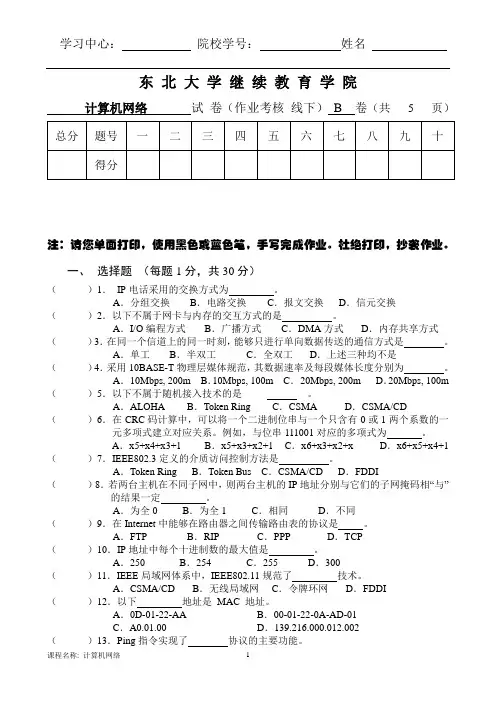
东北大学继续教育学院计算机网络试卷(作业考核线下)B 卷(共 5 页)注:请您单面打印,使用黑色或蓝色笔,手写完成作业。
杜绝打印,抄袭作业。
一、选择题(每题1分,共30分)()1.IP电话采用的交换方式为。
A.分组交换B.电路交换C.报文交换D.信元交换()2.以下不属于网卡与内存的交互方式的是。
A.I/O编程方式B.广播方式C.DMA方式D.内存共享方式()3.在同一个信道上的同一时刻,能够只进行单向数据传送的通信方式是。
A.单工B.半双工C.全双工 D.上述三种均不是()4.采用10BASE-T物理层媒体规范,其数据速率及每段媒体长度分别为。
A.10Mbps, 200m B.10Mbps, 100m C.20Mbps, 200m D.20Mbps, 100m ()5.以下不属于随机接入技术的是_____ ___。
A.ALOHA B.Token Ring C.CSMA D.CSMA/CD()6.在CRC码计算中,可以将一个二进制位串与一个只含有0或1两个系数的一元多项式建立对应关系。
例如,与位串111001对应的多项式为。
A.x5+x4+x3+1 B.x5+x3+x2+1 C.x6+x3+x2+x D.x6+x5+x4+1 ()7.IEEE802.3定义的介质访问控制方法是。
A.Token Ring B.Token Bus C.CSMA/CD D.FDDI()8.若两台主机在不同子网中,则两台主机的IP地址分别与它们的子网掩码相“与”的结果一定。
A.为全0 B.为全1 C.相同D.不同()9.在Internet中能够在路由器之间传输路由表的协议是。
A.FTP B.RIP C.PPP D.TCP()10.IP地址中每个十进制数的最大值是。
A.250 B.254 C.255 D.300()11.IEEE局域网体系中,IEEE802.11规范了技术。
A.CSMA/CD B.无线局域网C.令牌环网D.FDDI()12.以下地址是MAC 地址。

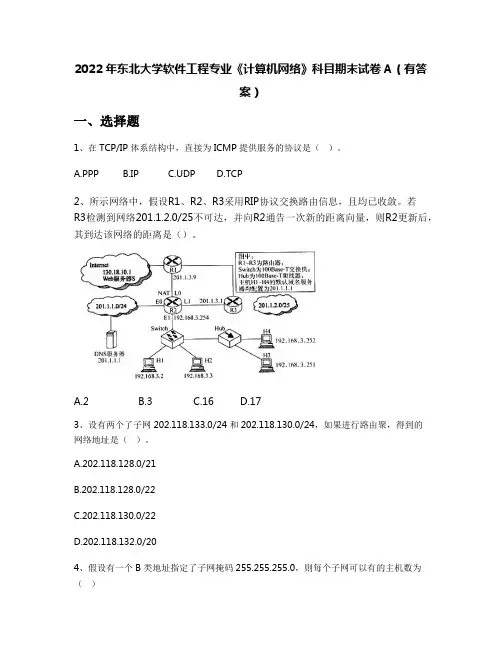
2022年东北大学软件工程专业《计算机网络》科目期末试卷A(有答案)一、选择题1、在TCP/IP体系结构中,直接为ICMP提供服务的协议是()。
A.PPPB.IPC.UDPD.TCP2、所示网络中,假设R1、R2、R3采用RIP协议交换路由信息,且均已收敛。
若R3检测到网络201.1.2.0/25不可达,并向R2通告一次新的距离向量,则R2更新后,其到达该网络的距离是()。
A.2B.3C.16D.173、设有两个了子网202.118.133.0/24和202.118.130.0/24,如果进行路由聚,得到的网络地址是()。
A.202.118.128.0/21B.202.118.128.0/22C.202.118.130.0/22D.202.118.132.0/204、假设有一个B类地址指定了子网掩码255.255.255.0,则每个子网可以有的主机数为()A.256B.254C.1024D.10225、在数据链路层中,网络互连表现为()A.在电缆段之问复制比特流B.在网段之间转发数据帧C.在网络之间转发报文D.连接不同体系结构的网络6、决定局域网特性有3个主要技术,它们是()A.传输介质、差错检测方法和网络操作系统B.通信方式、同步方式和拓朴结构C.传输介质、拓扑结构和介质访问控制方法D.数据编码技术、介质访问控制方法和数据交换技术7、假设某时刻接收端收到有差错的UDP用户数据报,其动作为()。
A.将其丢弃B.请求重传C.纠错D.忽略差错8、下列有关面向连接和无连接的数据传输的速度的描述,正确的说法是()。
A.面向连接的网络数据传输得快B.面向无连接的数据传输得慢C.二者速度一样D.不可判定9、()是TCPIP模型传输层中的无连接协议。
A.TCPB.IPC.UDPD.ICMP10、现给出一串二进制的文件:11001100 10000001 00111000,如果对该二进制文件进行base64编码,则最后所传送的ASCII码是()。
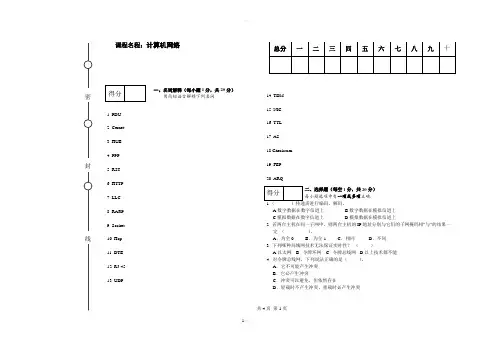
1. PDU2. Cernet3. HUB4. PPP5. RST6. HTTP7. LLC8. RARP9. Socket10. Hop 11. DTE 12. RJ-45 13. UDP共4页 第1页14. TDM 15. NIC 16. TTL 17. AS 18.Checksum 19. FEP 20. ARQ二、选择题(每空1分,共20分)每小题选项中有一项或多项正确.A.数字数据在数字信道上B.数字数据在模拟信道上C.模拟数据在数字信道上D.模拟数据在模拟信道上2. 若两台主机在同一子网中,则两台主机的IP 地址分别与它们的子网掩码相“与”的结果一定 ( )。
A .为全0B .为全1C .相同D .不同 3. 下列哪种局域网技术无法保证实时性? ( )A.以太网B. 令牌环网C. 令牌总线网D.以上技术都不能 4. 对令牌总线网,下列说法正确的是( )。
A .它不可能产生冲突 B .它必产生冲突C .冲突可以避免,但依然存在D .轻载时不产生冲突,重载时必产生冲突5. 下列INTERNET 协议中,能够进行地址映射的是( )。
A. ICMPB. ARPC. RARPD. DNS 6. 以太网交换机在网络帧碎片较多时,工作在( )状态下效率最高。
A .存储转发式(store and forword)B .直通式(cut through)C .改进的直通式D .学习 learning7. 下面协议中,( )使用伪首部进行校验。
A. IP 协议 B. TCP 协议C.UDP 协议D.ICMP 协议 8. IP 协议中,如果首部不含选项字段,则首部长度字段的值应为( )。
A. 0B. 5C. 10D. 209. 假设一个主机的IP 地址为192.168.5.121,而子网掩码为255.255.255.248,那么该主机的子网号为( ) A .192.168.5.12B .121C .15D .16810. 在通常情况下,下列说法中不正确的是( )。
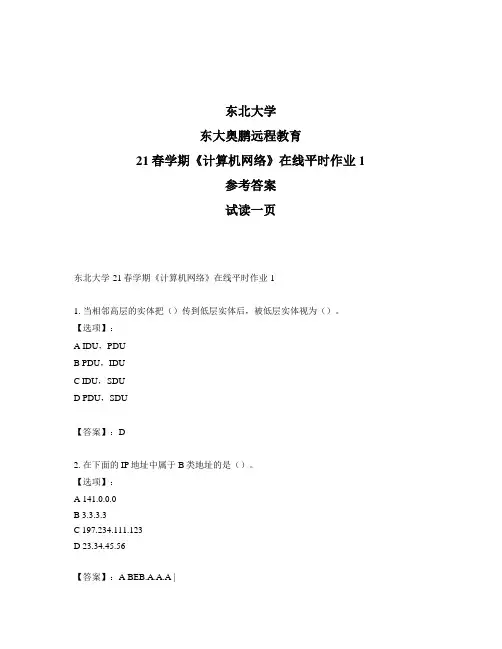
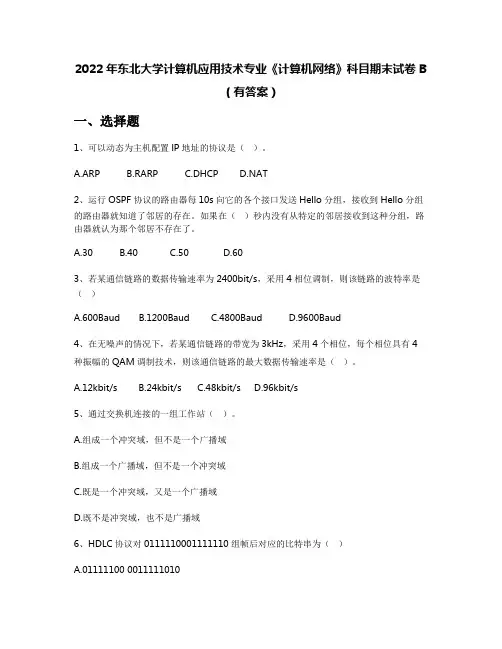
2022年东北大学计算机应用技术专业《计算机网络》科目期末试卷B(有答案)一、选择题1、可以动态为主机配置lP地址的协议是()。
A.ARPB.RARPC.DHCPD.NAT2、运行OSPF协议的路由器每10s向它的各个接口发送Hello分组,接收到Hello分组的路由器就知道了邻居的存在。
如果在()秒内没有从特定的邻居接收到这种分组,路由器就认为那个邻居不存在了。
A.30B.40C.50D.603、若某通信链路的数据传输速率为2400bit/s,采用4相位调制,则该链路的波特率是()A.600BaudB.1200BaudC.4800BaudD.9600Baud4、在无噪声的情况下,若某通信链路的带宽为3kHz,采用4个相位,每个相位具有4种振幅的QAM调制技术,则该通信链路的最大数据传输速率是()。
A.12kbit/sB.24kbit/sC.48kbit/sD.96kbit/s5、通过交换机连接的一组工作站()。
A.组成一个冲突域,但不是一个广播域B.组成一个广播域,但不是一个冲突域C.既是一个冲突域,又是一个广播域D.既不是冲突域,也不是广播域6、HDLC协议对0111110001111110组帧后对应的比特串为()A.01111100 0011111010B.01111100 01111101 01111110C.01111100 0111110103D.0111110001111110011111017、某IP网络的连接如图所示,在这种配置下IP全局广播分组不能够通过的路径是()。
A.计算机P和计算机Q之间的路径B.计算机P和计算机S之间的路径C.计算机Q和计算机R之间的路径D.计算机S和计算机T之间的路径8、计算机网络最基本的功能是()。
I.流量控制Ⅱ.路由选择 III.分布式处理 IV.传输控制A.I、Ⅱ、IVB. I、III、ⅣC.I、IVD. Ⅲ、IV9、图所示网络中,在OSl参考模型中,R1、Switch、Hub实现的最高功能层分别是()。
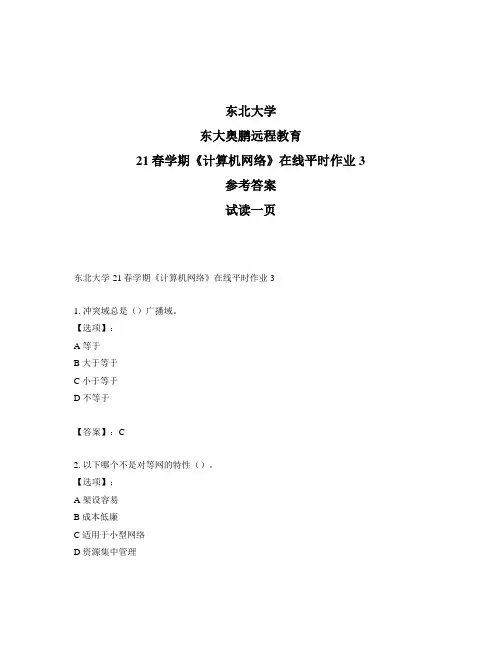
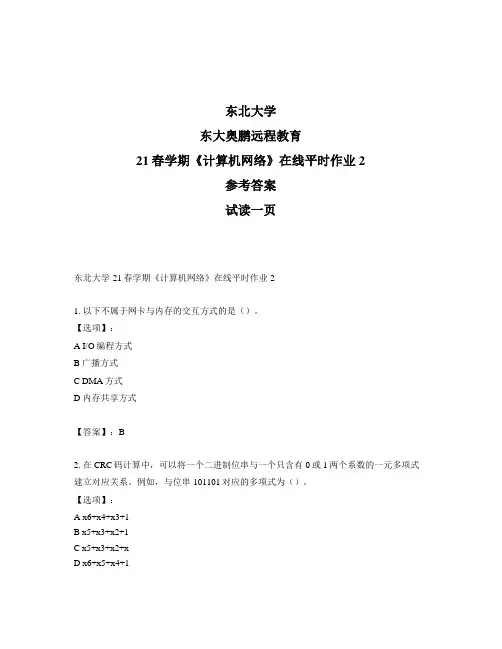

东北大学考试试卷(测验一) 2015 —2016 学年 第 一 学期 课程名称:计算机网络(Computer Networks ) 1. Circuit switching versus packet switching. (10’)a. Suppose that all of the network sources send data at a constant bit rate. Would packet-switching or circuit-switching be more desirable in this case? Why?b. Suppose that all of the network sources are bursty —that they only occasionally have data to send. Would packet-switching or circuit switching be more desirable in thiscase? Why?a. Circuit-switching is more desirable here because there are no statistical multiplexing gains to be had, and by using circuits, each connection will get a constant amount of bandwidth that matches its CBR rate. On the other hand, circuit-switching has more overhead in terms of signaling needed to set up the call, so there is an argument that packet-switching is preferable here since there is no call setup overhead with packet-switching. If this were an exam question either answer would be correct (as long as you provide the correct reasoning!).b. Packet-switching is better here because there are statistical multiplexing gains —when a source does not have data to send, it will not be allocated bandwidth (it would be unused when the source had nothing to send). With packet-switching, thisbandwidth is available for use by other sources. 2. Circuit switching. (15’)Consider sending a packet of F bits over a path of Q links. Each link transmits at R bps. Thenetwork is lightly loaded so that there are no queuing delays. Propagation delay is also negligible.a. Suppose the network is a packet-switched datagram network and a connection-oriented service is used. Suppose each packet has h * F bits of header where 0 < h < 1. Assuming t s setup time, how long does it take to send the packet?b. Suppose that the network is a circuit-switched network. Furthermore, suppose that the transmission rate of the circuit between source and destination is R /24 bps. Assuming t s setup time and no bits of header appended to the packet, how long does it take to send the packet?c. When is the delay longer for packet switching than for circuit switching assuming h=0.5. Interpret your result? a. The time required to transmit the packet over one link is (1 + h)F/R. The time required totransmit the packet over Q links is Q(1 + h)F/R Thus, the total delay for packet switching is Q(1 + h)F/R+t s . b. For ci rcuit switching, bits are not “store and forwarded” before each link. Thus, there is onlyone transmission delay of F/(R/24) = 24F/R. The total delay is 24F/R+t s . c. The delay is longer for packet switching when Q(1 + h)F/R + ts >24F/R + ts or equivalently when Q>16. Thus, if there are more than 16 links, packet switching has a larger delay, due tothe store and forwarding. If there are fewer than 16 links, circuit switching has a larger delay, due to its reduced transmission rate.5. Protocol layers. (10’) Array a. What are the five protocol layers, from top to bottom, in the Internet?b. For each of the five layers, what is the name of the packets processed at the layer?c. An end-system processes up to which layer?d. A router processes up to which layer?e. A link-layer switch processes up to which layer?a. application, transport, network, link, physicalb. message, segment, datagram, frame, packetc. an end-system processes up through the application layerd. a router processes up through the network layere. a link-layer switch processes up through the link layer6. Carrier sense and collision detection. (10’)Consider two nodes A and B on the same Ethernet segment, and suppose the propagation delay between the two nodes is 225 bit times. Suppose at time t=0 both nodes A and B begin to transmit a frame. At what time(in bit times) do they detect the collision? Assuming both nodes transmit a 48-bit jam signal after detecting a collision, at what time (in bit times) do nodes A and B sense an idle channel? How many seconds is this for a 10 Mbps Ethernet?Both nodes A and B detect the collision at time t=225. At time t = 225 + 48 = 273 both nodes stop transmitting their jam signals. The last bit of the jam signal from B arrives at A at time t = 273 + 225 = 498 bit times. Similarly, the last bit of the jam signal from B arrives at A at time t = 273 + 225 = 498 bit times. For a 10 Mbps Ethernet, thiscorresponds to (498 bits)/(107 bits/sec) = 49.8 microseconds.8. Multiple access protocols: voice-over-IP and data. (15’) Array In this chapter, we studied a number of multiple access protocols, including TDMA,CSMA, slotted Aloha, and token passing.a. Suppose you were charged with putting together a large LAN to support IP telephony(only) and that multiple users may want to carry on a phone call at the same time. Recallthat IP telephony digitizes and packetizes voice at a constant bit rate when a user ismaking an IP phone call. How well suited are these four protocols for this scenario?Provide a brief (one sentence) explanation of each answer.b. Now suppose you were charged with putting together a LAN to support the occasionalexchange of data between nodes (in this part of this question, there is no voice traffic).That is, any individual node does not have data to send very often. How well suited arethese four protocols for this scenario? Provide a brief (one sentence) explanation of eachanswer.c. Now suppose the LAN must support both voice and data and you must choose one ofthese multiple access strategies in order to support both applications on the samenetwork, with the understanding that voice calls are more important than data. Whichwould you choose and why? How would voice and data be sent in this scenario? That is,which access protocol would you use, or adapt/modify, and why?a. TDMA works well here since it provides a constant bit rate service of 1 slot per frame.CSMA will not work as work well here (unless the channel utilization is low) due tocollisions and variable amount of time needed to access the channel (for example,channel access delays can be unbounded) and the need for voice packets to be played outsynchronously and with low delay at the receiver. Slotted Aloha has the same answer asCSMA. Token passing works well here since each station gets a turn to transmit once pertoken round, yielding an essentially constant bit rate service.b. TDMA would not work well here as if there is only one station with something tosend, it can only send once per frame. Hence, the access delays are long (one half frametime on average), and the throughput over a long period of time is only 1/N of thechannel capacity. CSMA would work well since at low utilization, a node will get to usethe channel as soon as it need to. Slotted Aloha has the same answer as CSMA Tokenpassing would work better than TDMA but slightly less well than CSMA and SlottedAloha, since it must wait for the token to be passed to the other stations (who likely wouldn’t use it) before sending again.c. Here are two possible answers. One approach would be to divide the channel into two “pieces”-one for data packets and one for voice. This can be accomplished by assigning some number of TDMA slots for voice calls (for example, one slot to each user). Also, add some additional slots and allow the stations with data to send to perform random access (for example, slotted aloha or CSMA) within those data slots only. A second approach would be to use token passing with priorities, and give priority to voicepackets.。
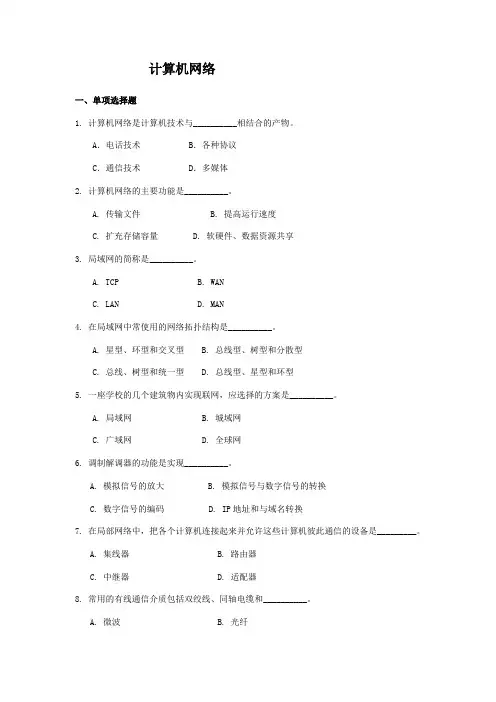
计算机网络一、单项选择题1. 计算机网络是计算机技术与__________相结合的产物。
A.电话技术 B.各种协议C.通信技术 D.多媒体2. 计算机网络的主要功能是__________。
A. 传输文件B. 提高运行速度C. 扩充存储容量D. 软硬件、数据资源共享3. 局域网的简称是__________。
A. TCPB. WANC. LAND. MAN4. 在局域网中常使用的网络拓扑结构是__________。
A. 星型、环型和交叉型B. 总线型、树型和分散型C. 总线、树型和统一型D. 总线型、星型和环型5. 一座学校的几个建筑物内实现联网,应选择的方案是__________。
A. 局域网B. 城域网C. 广域网D. 全球网6. 调制解调器的功能是实现__________。
A. 模拟信号的放大B. 模拟信号与数字信号的转换C. 数字信号的编码D. IP地址和与域名转换7. 在局部网络中,把各个计算机连接起来并允许这些计算机彼此通信的设备是_________。
A. 集线器B. 路由器C. 中继器D. 适配器8. 常用的有线通信介质包括双绞线、同轴电缆和__________。
A. 微波B. 光纤C. 激光D. 红外线9. 在计算机网络中,能够实现不同网络之间的协议转换互连设备是________。
A. 网桥B. 集线器C. 网关D. 路由器10. 因特网采用的通信协议是__________。
A. TCP/IPB. SP/IPXC. CSMA/CDD. X.2511.由中国教育科研计算机网与因特网相连的计算机网络简称是__________。
A. CHINANETB. CERNETC. CHINAGBNETD. CSTNET12. 中国公用计算机互联网的简称是__________。
A. CSTNETB. CHINAGBNETC. CERNETD. CHINANET13. 在网络中,用于放大远距离传输的电信号,可以采用设备是__________。
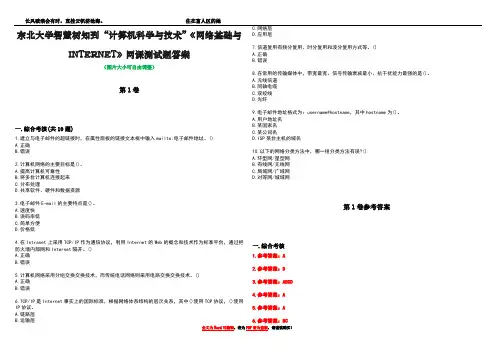
东北大学智慧树知到“计算机科学与技术”《网络基础与INTERNET》网课测试题答案(图片大小可自由调整)第1卷一.综合考核(共10题)1.建立与电子邮件的超链接时,在属性面板的链接文本框中输入mailto:电子邮件地址。
()A.正确B.错误2.计算机网络的主要目标是()。
A.提高计算机可靠性B.将多台计算机连接起来C.分布处理D.共享软件、硬件和数据资源3.电子邮件E-mail的主要特点是()。
A.速度快B.误码率低C.简单方便D.价格低4.在Intranet上采用TCP/IP作为通信协议,利用Internet的Web的概念和技术作为标准平台,通过把防火墙内部网和Internet隔开。
()A.正确B.错误5.计算机网络采用分组交换交换技术,而传统电话网络则采用电路交换交换技术。
()A.正确B.错误6.TCP/IP是Internet事实上的国际标准,根据网络体系结构的层次关系,其中()使用TCP协议,()使用IP协议。
A.链路层B.运输层C.网络层D.应用层7.信道复用有频分复用、时分复用和波分复用方式等。
()A.正确B.错误8.在常用的传输媒体中,带宽最宽、信号传输衰减最小、抗干扰能力最强的是()。
A.无线信道B.同轴电缆C.双绞线D.光纤9.电子邮件地址格式为:username@hostname,其中hostname为()。
A.用户地址名B.某国家名C.某公司名D.ISP某台主机的域名10.以下的网络分类方法中,哪一组分类方法有误?()A.环型网/星型网B.有线网/无线网C.局域网/广域网D.对等网/城域网第1卷参考答案一.综合考核1.参考答案:A2.参考答案:D3.参考答案:ABCD4.参考答案:A5.参考答案:A6.参考答案:BC7.参考答案:A8.参考答案:D9.参考答案:D10.参考答案:D。
东北大学考试试卷(测验二) 2015 —2016 学年 第 一 学期 课程名称:计算机网络(Computer Networks )1. Addressing at the network and link layers, routing versus switching.Consider the network shown below. Each of the subnets A-D contains at most 31 hosts; subnet E connects routers R1 and R2. a. Assign network addresses to the five subnets shown above (that is, write down the addresses you have assigned). b. Assign (write down) a full (32-bit) IP address for each the two hosts shown insubnets A and D.c. Assign (write down) a full IP address to the router interface on subnet E.d. What is the network prefix advertised by router R1 to the public Internet?e. Assign (write down) a MAC address to D.f. Does the host in A ever need to know the MAC address of the R1’s interfa ce in subnet E in order to send an IP packet to the host in D? Explain your answer in one or two sentences. Now suppose that router R2 above is replaced by an Ethernet switch , S2 (Router R1 remains a router).g. Are the interfaces that previously were in subnets A, B, and E still in the same separate three IP subnets now that R2 is replaced by S2? Explain your answer in a few sentences.h. In order to send an IP packet to the host in D, does the host in A ever need to know the MAC address of the R1’s left i nterface now that R2 is replaced by S2? If so, how does it get the MAC address of R1’s left interface? Explain your answer in one or two sentences. Answer:a. Each subnet needs to address up to 31 hosts, using the rightmost 5 bits of the address. Thefive subnet addresses are thus x.y.z.000_/27, x.y.z.001_/27, x.y.z.010_/27, x.y.z.011_/27, x.y.z.100_/27, where the notation x.y.z.000_ means that the leftmost three bits of the fourthaddress byte are 000. Other answers with different bit values in bits 25, 26, 27 are also possible, as long as the five three-bit patterns used are unique. b. If you chose an address range x.y.z.000_/27 for network A, then the address you choose here must have these 27 leading bits, and can have any 5 remaining bits you want. If you chose an address range x.y.z.011_/27 for network D, then the address you choose here must have these 27 leading bits, and can have any 5 remaining bits you want. c. If you chose an address range x.y.z.100_/27 for network E, then the address you choose here must have these 27 leading bits, and can have any 5 remaining bits you want. d. x.y.x.>24 e. Any 48 bit number is OK.f. No. The host in subnet A needs to address a link-layer frame (containing the IP packetaddresses to the host in D) to the R2 interface in subnet A only.g. No. They are now all in the same subnet from an IP addressing point of view, since there is no longer any intervening router. h. Yes. Now the host in A now needs to address its link-layer frame to the left interface of R1. The host in A gets the MAC address of the left interface of R1 using ARP. The host in A knowsthat in order to route its packet to the host in D, it must first send that packet (over Ethernet) to router R1, whose IP address is in the hosts routing table. Thus, it uses ARP to get the MAC address associated with the IP address of R1’s left interface .b.The shortest path from E to B is E F B. The cost of this path is 6. c.The shortest path from B to D is B A C D. The cost of this path is 5.on of Dijkstra’s (link -state) algorithm for computing the least cost path from D to all destinations. What is the shortest path from D to B, and what is the cost of this path? b. Show the operation of Dijkstra’s (link -state) algorithm for computing the least cost path fromThe shortest path from D to B is D C A B. The cost of this path is 5.b. From its neighbors, nodes A, B, and D. Note that C does not receive distance vectors from nodes E and F, since they are not direct neighbors.c. See page 358 in the textbook for notation. C’s cost to E via B is c(C,B) + DB(E) = 8 + 6 = 14.C’s cost to E via A is c(C,A) + DA(E) = 2 + 7 = 9 (note that A’s shortest path to E is through C!)C’s cost to E via D is c(C,D) + DD(E) = 1 + 4 = 5Thus, C will route to E via D, since that path through D has minimum cost.d. From its neighbors, nodes B, D, and F. Note that E does not receive distance vectors from nodes A and C, since they are not direct neighbors.e. See page 358 in the textbook for notation. E’s cost to B via B is c(E,B) + DB(B) = 10 + 0 = 10. E’s cost to B via D is c(E,D) + DD(B) = 4 + 5 = 9. E’s cost to B via F is c(E,F) + DF(B) = 2 + 4 = 6.Thus, E will route to B via F, since that path through F has minimum cost.a. What are A, B, C, D, E, and F’s distance vectors? Note: you do not have should be able to compute distance vectors by inspection. node’s distance vector is the vector of the least cost paths from itself to each of the other nodes ina. The first and second segments contain 20 and 40 bytes of data, respectively. In the second segment sent from A to B, the sequence number is 165, the source port number is 303, and the destination port number is 80.b. The first acknowledgment has acknowledgment number 165, source port80, and destination port 303.c. The acknowledgment number will be 145, indicating that it is still waiting for bytes 145 and onward.d. The sequence number of the retransmission is 145 and it carries 20 bytes of data. Theacknowledgment number of the additional acknowledgment is 205.。